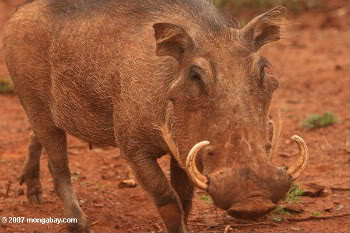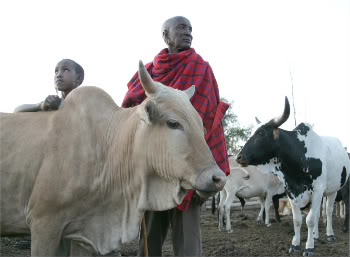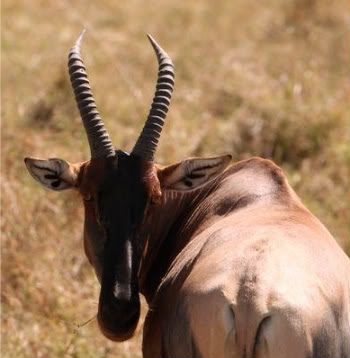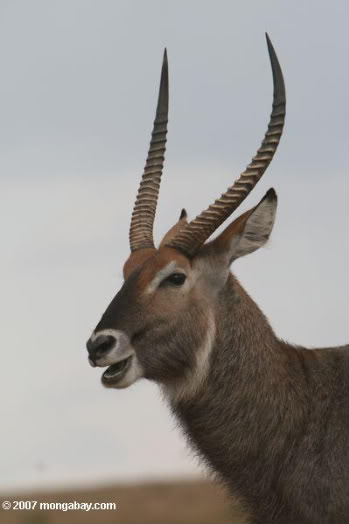In Masai Mara, one of Africa’s most treasured parks, researchers have found significant, in some cases catastrophic, declines of wild grazing animals. In fifteen years six of seven hoofed animals—giraffes, warthogs, hartebeest, impala, topis and waterbucks—showed declines. The study published in the British Journal of Zoology confirms what has long been expected: wildlife populations in Masai Mara are plummeting due to increased competition with humans and livestock.
The Masai Mara National Reserve lies over 1500 square kilometers in southwestern Kenya where it eventually links to Serengeti park in Tanzania. Heavily visited by tourists, the park is one of the best places in the world to see the famous wildebeest migration.
 According to a new study warthogs have declined by 80 percent in fifteen years in Kenya’s Masai Mara Reserve. Photo by: Rhett A. Butler. |
Researchers from the International Livestock Research Institute (ILRI) conducted surveys of species every month for fifteen years, from 1989 to 2003. Giraffes fared the worse: dropping an astounding 95 percent in fifteen years. Warthog populations fell 80 percent. While hartebeest and impala dropped 76 percent and 67 percent respectively.
“The situation we documented paints a bleak picture and requires urgent and decisive action if we want to save this treasure from disaster,” said Joseph Ogutu, the lead author of the study and a statistical ecologist at ILRI. “Our study offers the best evidence to date that wildlife losses in the reserve are widespread and substantial, and that these trends are likely linked to the steady increase in human settlements on lands adjacent to the reserve.”
 Maasai elder and child with cattle. Photo courtesy of ILRI. |
>
The researchers point to the growing, largely impoverished, human population around the park as the reason for the wildlife declines. Lands that were once grazed by ungulates are being co-opted by humans for livestock and crops. In addition illegal hunting remains a persistent problem while incidents of wildlife killed for having broken fences, damaged crops, or threatened livestock is no longer uncommon.
“Wildlife are constantly moving between the reserve and surrounding ranchlands and they are increasingly competing for habitat with livestock and with large-scale crop cultivation around the human settlements,” Ogutu said. “In particular, our analysis found that more and more people in the ranchlands are allowing their livestock to graze in the reserve, an illegal activity the impoverished Maasai resort to when faced with prolonged drought and other problems.”
 The topi is one of six hoofed species to show significant decline. Photo by: Rhett A. Butler. |
The traditional peoples of the Mara, the semi-nomadic herders called the Maasai, have long co-existed peacefully with wildlife in the area. But recently the Maasai, due to long neglect by the Kenyan government, have abandoned traditional lifestyles and begun moving into more permanent settlements. The researchers note that in one of the Maasai ranchlands, the number of huts went from 44 in 1950 to 2,735 in 2003.
“The traditional livestock livelihoods of the Maasai, who rarely consume wild animals, actually helped maintain the abundance of grazing animals in East Africa, and where a pastoral approach to livestock grazing is still practiced, it continues to benefit wild populations,” said Robin Reid, a co-author of the paper who is now director of the Center for Collaborative Conservation at Colorado State University. “There appears to be a ‘tipping point’ of human populations above which former co-existence between Maasai and wildlife begins to break down. In the villages on the border of the Mara, this point has been passed, but large areas of the Mara still have populations low enough that compatibility is still possible.”
 The waterbuck is one of six hoofed species to show significant decline. Photo by: Rhett A. Butler. |
Currently, the Maasai are working with tourism companies to establish areas where the number of human settlements and livestock would be carefully managed to provide suitable habitat and grazing land for the reserve’s world famous wildlife. The Maasai community receives a portion of profits from tourism in the park.
“We know from thousands of years of history that pastoral livestock-keeping can co-exist with East Africa’s renowned concentrations of big mammals. And we look to these pastoralists for solutions to the current conflicts,” said Carlos Seré, Director General of ILRI. “With their help and the significant tourism revenue that the Mara wildlife generates, it is possible to invest in evidence-based approaches that can protect this region’s iconic pastoral peoples, as well as its wildlife populations.”
Related articles
Fire in Kenya threatens some of the world’s most beloved parks
(03/24/2009) Started by arsonists, fires have swept through Kenya’s Great Rift valley, home of some of the world’s most treasured parks and ten million Kenyans already suffering from long-term drought.
All about giraffes: an interview with a giraffe expert
(03/09/2009) Dr. Julian Fennessy probably knows the giraffe better than anyone. Trekking across savannah, forest, and the deserts of Africa, Fennessy is collecting genetic samples of distinct giraffe populations and overturning common wisdom regarding their taxonomies. It had long been accepted knowledge that the giraffe was made up of one species and several subspecies, however with Fennessy’s work it now appears that several of the subspecies may in fact be distinct species. Such discoveries could have large conservation impacts, since conservation funds and efforts are largely devoted to species. The giraffe has suffered significant declines in the past decade with the total population dropping some 30 percent across Africa.
Africa’s lions are disappearing
(03/25/2008) The lion is Africa’s best known carnivore. Once widely abundant across the continent, recent surveys show that lion populations have plunged from over 100,000 individuals to around 23,000 over the past century. The reason? Lions are poisoned, shot, and speared by locals who see them as a threat to livestock. While lion populations in protected areas remain relatively healthy, conservationists say that without urgent measures, lions may disappear completely from unprotected areas. The Kilimanjaro Lion conservation Project is working to avoid this fate by developing practical measures to encourage coexistence between people, livestock and predators. Key to the effort is reducing livestock losses to lions. Leela Hazzah, a field researcher with the project, says the “Lion Guardians” program at Mbirikani Ranch in Kenya has proved remarkably successful: not a single lion has been killed since its inception in November 2006. The program employs Maasai warriors to monitor lions and help local communities prevent attacks on livestock.














